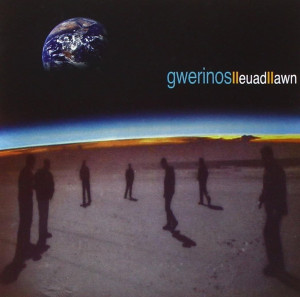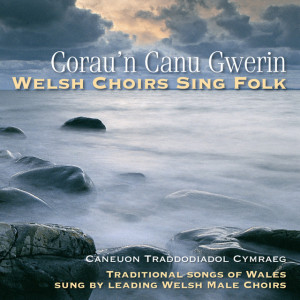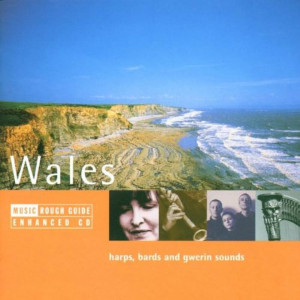 Welsh music is often known for its harps, male choirs, and its pibgorn or hornpipe; the Welsh people themselves often given the reputation for a certain dark, dour nature, and deep religious bent. Although Wales is right in the center of the British Isles, its music is relatively neglected among the Celtic traditions and has an ancient sensibility, made up of elements of the baroque and renaissance with a distinctive Celtic flair. It tends to be more somber and stately than the wildness of Irish or Scottish traditional music, with a quality that the Rough Guide folks call “innocent.” I’d call it heart; there is something direct and unhurried.
Welsh music is often known for its harps, male choirs, and its pibgorn or hornpipe; the Welsh people themselves often given the reputation for a certain dark, dour nature, and deep religious bent. Although Wales is right in the center of the British Isles, its music is relatively neglected among the Celtic traditions and has an ancient sensibility, made up of elements of the baroque and renaissance with a distinctive Celtic flair. It tends to be more somber and stately than the wildness of Irish or Scottish traditional music, with a quality that the Rough Guide folks call “innocent.” I’d call it heart; there is something direct and unhurried.
Many of the artists reviewed here seem to be able to get to that heart, while making music that is accessible and occasionally sophisticated. I enjoy the similarities to the Breton styles — in the piping, the melodies and, to a lesser extent, the vocals — yet the kinship with English traditions is also quite evident. I’ve heard that Wales is a beautiful, if brooding, place, and I can well believe it is both, if this music reflects its spirit.
Not surprisingly, these albums boast some fine vocal performances, and some interesting similarities with related Celtic and European traditions. There is both the call-and-response singing and the interesting harmonies that one would expect in a land of choirs. There are also some very fine female vocal performances, all with a distinctive style that is quite different that of neighboring Ireland, Scotland and England.
Because they hearken back to Renaissance and Baroque styles, there is a surprising similarity with some of the continental traditions with similar roots. I was particularly reminded of the Scandinavian traditions on some instrumentals, a tradition that is also enjoying a comeback. The instrumental numbers are often quite satisfying and fresh, and reflect a resurgent interest in Welsh instruments that has come along with the success of the Welsh language and a revival of the culture. The flute and whistle feature prominently in most of these albums, often giving the music a pleasing lightness. I get the sense from this music that the memories of a grim mining and industrial past are fading with the tentative blossoming of the economy. The music isn’t as brash as the portrayals of the new developments in Cardiff, where the harbour is being turned into a lake, but they do reflect an enthusiasm and sophistication that is often captivating.
Crasdant’s self titled instrumental album has several gems and lots of great numbers by an accomplished foursome who combine the triple harp, pibgorn, whistles, flutes and guitar. This disc will be very accessible to fans of several folk traditions and stands up well to most instrumental albums in either the Scottish or Irish traditions. The format will be familiar to Celtic music fans, with sets of tunes in simple, relaxed arrangements that are varied though not nearly as much as that of Ogam, which is reviewed below.
Crasdant boast some accomplished members. Triple harpist Robin Huw Bowen is the unofficial ambassador of Welsh music to the world and the author of an influential collection of Welsh hornpipes. Stephen Rees, playing fiddle, accordion, whistles and D pibgorn, was member of the long running group Ar Log in his youth, later pursuing a degree in music focusing on Welsh instruments. He is currently a lecturer at the University of Bangor. Huw Williams, guitar and clogging, has published a book on Welsh clogging and is part of a singer-songwriter duo. Andy McLauchlin rounds out the group on whistles, wooden flute and G pibgorn. Crasdant manage to bring out the baroque elements of the music while remaining relaxed. They make it feel that this is music real people could play. Williams’s feet provide the only percussion, but that element really adds to approachability of the album.
The first track sets the tone, played on a set of three hornpipes, harp, and fiddle, punctuated by Williams’ stepping and occasional “Hey!” The pace varies between these bright sets and slower harp tunes, which range from the tender to the sad. In addition to the first set of hornpipes is a set of marches, “Ymdaith y Siandlwr/Hela’r Sgyfarnog/Cainc Ifan Ddall” or “The Chandler’s March/Hunting the Hare/The Tune of Blind Ifan.” There are two great piping duets: “Y Crwtyn Llwyd (The Grey Lad)” is based on a tune from the early nineteenth century, and the slow and somber “Y Fedl Fawr/Coleg y Brifysgol Abertawe,” or “The Great Medley/Univesity College, Swansea,” combines the pibgorn with the harp to great effect. The pibgorn is a less raucous instrument than some other pipes — at least when played by these two. It fits in very well with the gentle but lively music of the harp and flutes played here.
This debut album is gentle, sensitive and graceful. I found it soothing without being cloying, with some sad, evocative moments, and some bright, easy numbers. Fans of other Celtic instrumental traditions will enjoy this  album, so different in melody and accent, but familiar in the structure of the sets of dance-oriented tunes combined with longer airs.
album, so different in melody and accent, but familiar in the structure of the sets of dance-oriented tunes combined with longer airs.
Gwerinos brings the traditional instruments of rock to the traditional music of Wales, for a folk rock treatment, sung mostly in Welsh, adding a bass, drum kit, banjo and a little humor to some traditional and not-so-traditional melodies. The liner notes are mostly in Welsh, leaving me puzzled on several accounts; readers in the know will have to bear with me. I think these guys play a good live gig, because they ham it up a lot on this disc, which works better in some places than others. Gwerinos are Elfed ap Gomer on accordion among others, Jôs on djembe and other percussion, Marc Jones on bas (bass, I presume), Irdis Morris Joneson on fiddle, Tudur Huws Jones on banjo, mandolin and so forth, as well as writing much of the music. Also, Ywain Myfyr on guitar and so forth, and Emlyn Roberts, also on guitar, bouzouki, and assorted stringed instruments. Lleuadllawn opens with a great instrumental set of reels entitled “Nyth y Gwcw,” apparently reels are a rare commodity in Welsh traditional music, but these are great tunes, a bit less syncopated than your typical Irish reel. It’s followed by a rollicking number that translates, “Two Young Pups,” paired with an original composition by Jones.
The third track is a growling R&B number that seems out of place here, and not all that welcome in my book, but then again it’s an ode to a department store. I think you probably had to be there to get this one. Despite a couple of stinkers, there are some good tracks that follow this introduction, including “Drws y Coed,” again written by Tudur Huws Jones. “Lloerig” is also a fine instrumental number written by Emlyn Roberts. The other notable track on this album is “Mynd yn Ôl,” a song that mines a theme familiar to Celtic traditions — longing for home from a strange land. Even without understanding the lyrics, it’s obviously a song that tugs on the heart strings. I also liked “Lluniau,” an original by Ywain Myfyr, which has nice understated drum line along with voice and whistle.
There are several great songs on this disc that deserve wider exposure, but also a few that seem intended for local audiences, or live performances only, even one that must be a singalong (“Mr. Puw”) live, but doesn’t necessarily earn its place on this disc. These tracks are quite ordinary in terms of rock sensibilities, and broke up the flow of the album, distracting me from some of the more interesting material. If you enjoy folk rock and  want an accessible introduction to Welsh sensibilities, Lleuadllawn might be for you. I’d hope to see more of the more traditionally oriented original material played with a rock sensibility in Gwerinos’ next effort, and less of the slapstick rock-oriented numbers.
want an accessible introduction to Welsh sensibilities, Lleuadllawn might be for you. I’d hope to see more of the more traditionally oriented original material played with a rock sensibility in Gwerinos’ next effort, and less of the slapstick rock-oriented numbers.
Ogam’s O Gam I Gam (there must be something to this title but it goes right over this country girl’s head)* will appeal to fans of baroque and early music as well as folkies. This mostly instrumental album is light and graceful, with an interesting balance between whistles or flute and strings. There is a great attention to detail and phrasing in this music. I can’t but suspect classical training for these musicians; the passages are longer and more interesting than one usually associates with folk music. I particularly liked “Lleuad newydd,” which has a great deal of drama and some conversation between the fiddle and the flute. I also really enjoyed the following track, “Pigau’r Dur/Difyrrwch yr heusor du,” a composition by Marc Davies, which carries on with the lighthearted but interesting feel. This interpretation of Welsh traditional material bridges several styles to great effect. It makes for very pleasant listening — a great tonic for those afternoons when one wants to concentrate but needs a little push.
I was a bit frustrated by the call-and-response song “Y mab afradlon.” I would have liked to see a stronger arrangement here. It’s obviously a happy song, but the combination of the alternating male/female vocals, flute and the very bright melody was a bit too much for me. On the other hand, a very similar arrangement works well on the next instrumental, “Cân diogi.” The tune is similar, and it really works without the vocals. Another standout is “Clwmp Pump” which has some great passages where the harp and fiddle trade off the lead melody. Finally, I must mention “The Curly Headed Ploughboy/The Tipsy Parson” for the nice exchange between the whistle and fiddle. Both are light, pleasing numbers that keep up the pace of the album.
Ogam seem to have more upbeat numbers than some of the other groups reviewed here, all presented with an upright, lightly-syncopated rhythm in stately, understated arrangements. Percussion is non-existent, which contributes to a sense of floating along on a breeze. It’s all very civilized, yet lively. I would have liked more detail on the songs and the instruments on the liner notes, which are oddly grim and gray, given the nature of the  music. This album will please fans of several instrumental folk and classical traditions, particularly those with a love of the baroque, and the less raucous Celtic ensembles.
music. This album will please fans of several instrumental folk and classical traditions, particularly those with a love of the baroque, and the less raucous Celtic ensembles.
Although Wales is known for its male choirs, these choirs predominate in the English-speakng coal mining regions that once boasted the highest concentration of coal mines anywhere in the world, and these regions were once the destination of many immigrants, particularly Irish immigrants. Oddly enough, this portion of Wales is also known for being more relaxed and exuberant than other Welsh regions, at least according to my rather impersonal sources. The last working coal mine is now employee-owned and turning a profit, and the choirs once formed by miners persist as a cultural artifact of a bygone era of bosses, strikes and union organizing. Welsh Choirs Sing Folk has some of these choirs turning from their traditional scriptural material to songs from the native traditions.
This disc will appeal to fans of choral music but may not be the ticket for the general listener with a only passing interest in the music of Wales. As a pure example of choral singing, this disc delivers, but the production is a very straight-forward and prosaic studio recording, without the rough, raw heart that one sometimes hears on field recordings, or the nuances of a dramatic or theatrically-oriented production. Having said that, there are some fine songs here, although I would have preferred some instrumental interludes. I’m not asking for long solos or guest guitarists, just some variety and pacing.
It’s difficult to pick a standout performance, as all are good (for those of you with memories of the local divas in the church choir, rest assured they didn’t make it on to this disc). I did particularly enjoy Dunvant Male Choir’s/Côr Meibon Dyfnant’s “Fantasia on Famous Welsh Airs.” Another powerful number was “Dacw ŒNgharaid,” or “There is my Love,” sung by Côr Meibon Pendyrus/Penyrus male Choir. Burry Port Male Choir/ Côr Meibon Porth Tywyn deliver a simple but effective arrangement of “Lisa Lân” or “Fair Lisa.” “Hen Ferchetan” or “the Old Spinster” is another memorable number by Côr Meibon Penhryn/Penhryn Male Choir.
This is a fine album for those with a special interest in choral singing, or  those who have heard and enjoyed this music and want to keep the memories alive. This is not the album to begin with; that honor goes to the next CD that I review.
those who have heard and enjoyed this music and want to keep the memories alive. This is not the album to begin with; that honor goes to the next CD that I review.
Like most of the Rough Guide products, Wales is stylish and well done. It points the way to the featured artists’ work and provides a brief introduction to the traditions of Wales via the enhanced CD, which also points the way to Rough Guide’s world music net, and of course, more product. There are also some bonus tracks unrecorded elsewhere: in this case, Julie Murphy and Dylan Fowler, as well as some heritage recordings, although there are fewer of these than on other discs. I was particularly impressed by Rag Foundation, whose “Mynd I Rymni” reminded pleasantly of Richard Thompson, both in the the lead singer’s vocal qualities and the sense of tension created by its guitar accompaniment. This is definitely a group I’d like to hear more from. Another standout is Julie Murphy, from North Wales, who appears twice, treating us to a beautiful voice, great songs and understated arrangements.
“Capel Rhydwilym,” recorded in 1967, is actually the singing of scripture, often in all-day or all-weekend song-fests. It’s in Welsh, so I can only comment on the unusual rhythms and harmonies. It’s reminiscent of American shape note singing, no doubt because it shares the same mixture of untrained voices and simmilar roots with older harmonic styles. John Morgan’s slow and stately concertine numbers “Lawr A’r Ffrancod/Medley Caerfaddon” are a delight, as is the piping of Ceri Rhys Mathews and Jonathon Shorland.
Pigyn Clust, a group from North Wales, boast an excellent singer, accompanied by harp and fiddle in a gentle yet lilting song, “Merched,” which contains an improvised combination of melody and verse from two different songs — a technique that has become popular among young bands, according to the liner notes. Another stand-out female performance, here punctuated by piping is by Fernhill’s July Murphy, entitled “Fi Wela.” This is hard to beat. I also have to recommend Meic Stevens, Wales‚ most admired singer-songwriter, singing “Breuddwydion.” He’s obviously earned his reputation with dramatic and clear performances like this one, now if only there was a translation…
This is a good place to start if you, like many outside Wales, are not familiar with Welsh folk music, as there is not a bad track on the disc and there are some great pointers to more material. The music is stately and understated and will likely appeal to fans of related Celtic traditions as well as English traditions. But it’s not a static or stodgy interpretation of Welsh music. I would have liked to see more heritage recordings juxtaposed with current players, but I can’t quibble with the good sense of the Rough Guide folks.
[Kim Bates]
[Carreg Lafar’s Hyn is another excellent example of great Welsh music, with some really stunning numbers — it has become one of my favorite discs since I reviewed it in 2000. For even more reviews of Welsh folk music see an earlier GMR omnibus review of several albums by Vonnie Carts-Powell. Yes folks, I cheated — the U.S. edition of National Geographic came out with an article on Wales in the June 2001 issue. Sadly lacking in information about the music of Wales, it does have some other good stuff like info on coal mines and the harbour in Cardiff.]
[Update: Poor Kim, writing before the advent of Google Translate, would now easily be able to deduce that “O Gam I Gam” means Step To Step.]
(Sain, 1999)
(Sain, 1999)
(Sain, 2000)
(Sain, 1998)
(Rough Guides, 2000)
